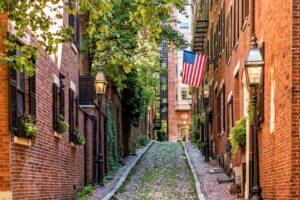Fodor's Expert Review Faneuil Hall Marketplace
Faneuil Hall (pronounced Fan-yoo'uhl or Fan-yuhl) was erected in 1742, the gift of wealthy merchant Peter Faneuil, who wanted the hall to serve as both a place for town meetings and a public market. It burned in 1761 and was immediately reconstructed according to the original plan of its designer, the Scottish portrait painter John Smibert (who lies in the Granary Burying Ground). In 1763 the political leader James Otis helped inaugurate the era that culminated in American independence when he dedicated the rebuilt hall to the cause of liberty.
In 1772 Samuel Adams stood here and first suggested that Massachusetts and the other colonies organize a Committee of Correspondence to maintain semiclandestine lines of communication in the face of hardening British repression. In later years the hall again lived up to Otis's dedication when the abolitionists Wendell Phillips and Charles Sumner pleaded for support from its podium. The tradition continues to this day: in presidential-election... READ MORE
Faneuil Hall (pronounced Fan-yoo'uhl or Fan-yuhl) was erected in 1742, the gift of wealthy merchant Peter Faneuil, who wanted the hall to serve as both a place for town meetings and a public market. It burned in 1761 and was immediately reconstructed according to the original plan of its designer, the Scottish portrait painter John Smibert (who lies in the Granary Burying Ground). In 1763 the political leader James Otis helped inaugurate the era that culminated in American independence when he dedicated the rebuilt hall to the cause of liberty.
In 1772 Samuel Adams stood here and first suggested that Massachusetts and the other colonies organize a Committee of Correspondence to maintain semiclandestine lines of communication in the face of hardening British repression. In later years the hall again lived up to Otis's dedication when the abolitionists Wendell Phillips and Charles Sumner pleaded for support from its podium. The tradition continues to this day: in presidential-election years the hall is the site of debates between contenders in the Massachusetts primary.
Faneuil Hall was substantially enlarged and remodeled in 1805 according to a Greek Revival design of the noted architect Charles Bulfinch; this is the building you see today. Its purposes remain the same: the balconied Great Hall is available to citizens' groups on presentation of a request signed by a required number of responsible parties; it also plays host to regular concerts.
Inside Faneuil Hall are dozens of paintings of famous Americans, including the mural Webster's Reply to Hayne and Gilbert Stuart's portrait of Washington at Dorchester Heights. Park rangers give informational talks about the history and importance of Faneuil Hall every half hour. There are interactive displays about Boston sights, and National Park Service rangers at the visitor center on the first floor can provide maps and other information.
On the building's top floors are the headquarters and museum and library of the Ancient and Honorable Artillery Company of Massachusetts, which is free to visit (but a donation is welcome). Founded in 1638, it's the oldest militia in the Western Hemisphere, and the third-oldest in the world, after the Swiss Guard and the Honourable Artillery Company of London. The museum is open Wednesday through Friday from 11 am to 3 pm.
When such men as Andrew Jackson and Daniel Webster debated the future of the Republic here, the fragrances of bacon and snuff—sold by merchants in Quincy Market across the road—greeted their noses. Today the aroma of coffee wafts through the hall from a snack bar. The shops at ground level sell New England bric-a-brac. This is Freedom Trail stop 11.
READ LESS






